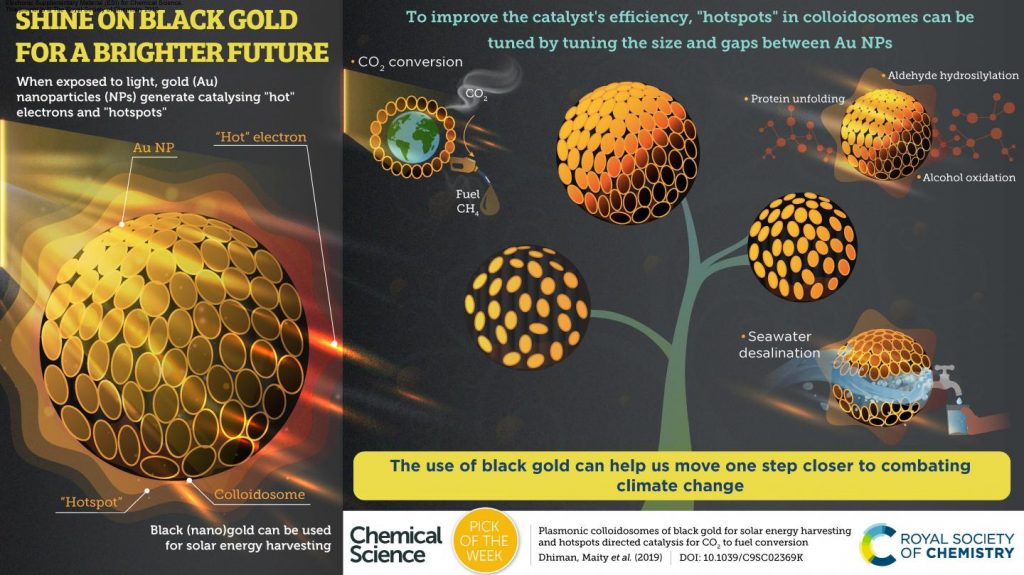A July 3, 2019 news item on Nanowerk describes research coming from India and South Korea where nano gold is turned into black nanogold (Note: A link has been removed),
One of the main cause of global warming is the increase in the atmospheric CO2 level. The main source of this CO2 is from the burning of fossil fuels (electricity, vehicles, industry and many more).
Researchers at TIFR [Tata Institute of Fundamental Research] have developed the solution phase synthesis of Dendritic Plasmonic Colloidosomes (DPCs) with varying interparticle distances between the gold Nanoparticles (AU NPs) using a cycle-by-cycle growth approach by optimizing the nucleation-growth step. These DPCs absorb the entire visible and near-infrared region of solar light, due to interparticle plasmonic coupling as well as the heterogeneity in the Au NP [gold nanoparticle] sizes, which transformed golden gold material to black gold (Chemical Science, “Plasmonic colloidosomes of black gold for solar energy harvesting and hotspots directed catalysis for CO2 to fuel conversion”).
…
A July 3, 2019 Tata Institute of Fundamental Research (TIFR) press release on EurekAlert, which originated the news item, provides more technical detail,
Black (nano)gold was able to catalyze CO2 to methane (fuel) conversion at atmospheric pressure and temperature, using solar energy. They also observed the significant effect of the plasmonic hotspots on the performance of these DPCs for the purification of seawater to drinkable water via steam generation, temperature jump assisted protein unfolding, oxidation of cinnamyl alcohol using pure oxygen as the oxidant, and hydrosilylation of aldehydes.
This was attributed to varying interparticle distances and particle sizes in these DPCs. The results indicate the synergistic effects of EM and thermal hotspots as well as hot electrons on DPCs performance. Thus, DPCs catalysts can effectively be utilized as Vis-NIR light photo-catalysts, and the design of new plasmonic nanocatalysts for a wide range of other chemical reactions may be possible using the concept of plasmonic coupling.
Raman thermometry and SERS (Surface-enhanced Raman Spectroscopy) provided information about the thermal and electromagnetic hotspots and local temperatures which was found to be dependent on the interparticle plasmonic coupling. The spatial distribution of the localized surface plasmon modes by STEM-EELS plasmon mapping confirmed the role of the interparticle distances in the SPR (Surface Plasmon Resonance) of the material.
Thus, in this work, by using the techniques of nanotechnology, the researchers transformed golden gold to black gold, by changing the size and gaps between gold nanoparticles. Similar to the real trees, which use CO2, sunlight and water to produce food, the developed black gold acts like an artificial tree that uses CO2, sunlight and water to produce fuel, which can be used to run our cars. Notably, black gold can also be used to convert sea water into drinkable water using the heat that black gold generates after it captures sunlight.
This work is a way forward to develop “Artificial Trees” which capture and convert CO2 to fuel and useful chemicals. Although at this stage, the production rate of fuel is low, in coming years, these challenges can be resolved. We may be able to convert CO2 to fuel using sunlight at atmospheric condition, at a commercially viable scale and CO2 may then become our main source of clean energy.
Here’s an image illustrating the work

A July 3, 2019 Royal Society of Chemistry Highlight features more information about the research,
A “black” gold material has been developed to harvest sunlight, and then use the energy to turn carbon dioxide (CO2) into useful chemicals and fuel.
In addition to this, the material can also be used for applications including water purification, heating – and could help further research into new, efficient catalysts.
“In this work, by using the techniques of nanotechnology, we transformed golden gold to black gold, by simply changing the size and gaps between gold nanoparticles,” said Professor Vivek Polshettiwar from Tata Institute of Fundamental Research (TIFR) in India.
Tuning the size and gaps between gold nanoparticles created thermal and electromagnetic hotspots, which allowed the material to absorb the entire visible and near-infrared region of sunlight’s wavelength – making the gold “black”.
The team of researchers, from TIFR and Seoul National University in South Korea, then demonstrated that this captured energy could be used to combat climate change.
Professor Polshettiwar said: “It not only harvests solar energy but also captures and converts CO2 to methane (fuel). Synthesis and use of black gold for CO2-to-fuel conversion, which is reported for the first time, has the potential to resolve the global CO2 challenge.
“Now, like real trees which use CO2, sunlight and water to produce food, our developed black gold acts like an artificial tree to produce fuel – which we can use to run our cars,” he added.
Although production is low at this stage, Professor Polshettiwar (who was included in the RSC’s 175 Faces of Chemistry) believes that the commercially-viable conversion of CO2 to fuel at atmospheric conditions is possible in the coming years.He said: “It’s the only goal of my life – to develop technology to capture and convert CO2 and combat climate change, by using the concepts of nanotechnology.”
Other experiments described in the Chemical Science paper demonstrate using black gold to efficiently convert sea water into drinkable water via steam generation.
It was also used for protein unfolding, alcohol oxidation, and aldehyde hydrosilylation: and the team believe their methodology could lead to novel and efficient catalysts for a range of chemical transformations.
Here’s a link to and a citation for the paper,
Plasmonic colloidosomes of black gold for solar energy harvesting and hotspots directed catalysis for CO2 to fuel conversion by Mahak Dhiman, Ayan Maity, Anirban Das, Rajesh Belgamwar, Bhagyashree Chalke, Yeonhee Lee, Kyunjong Sim, Jwa-Min Nam and Vivek Polshettiwar. Chem. Sci., 2019, Advance Article. DOI: 10.1039/C9SC02369K First published on July 3, 2019
This paper is freely available in the open access journal Chemical Science.